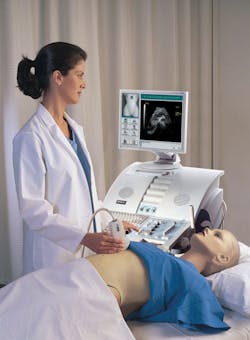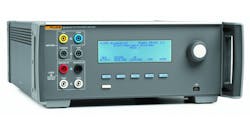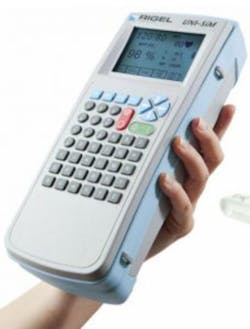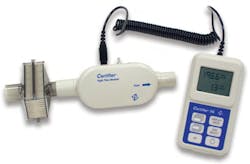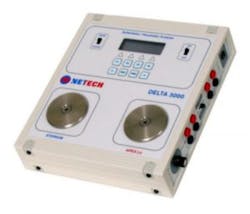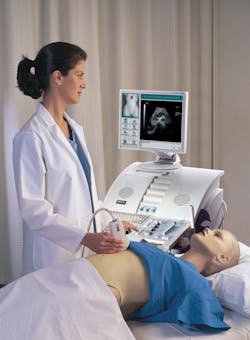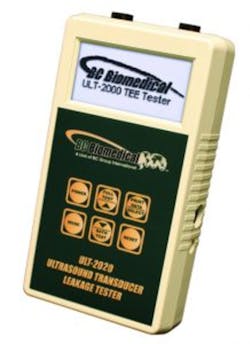Modern medical technology has made possible a wide range of procedures not available years ago. Many of these involve some kind of special equipment, such as electrosurgery devices, defibrillators, and ultrasound machines. When tools like these are calibrated and used within their operating guidelines, trained personnel can work wonders—diagnosing, treating, and rescuscitating effectively and efficiently.
Yet, what assurance does a doctor or paramedic have that the equipment really will work as required? That’s where biomedical test instrumentation comes in: specialized simulators and measuring products that deal with patient-specific parameters. Just as electrical engineers can choose between a voltmeter or a DMM, so too are there single-signal and multipurpose instruments for testing and calibrating biomedical equipment.
With 130 user-selectable loads in two ranges—0 Ω, 10 Ω, 20 Ω, and 25 Ω to 2,500 Ω in 25-Ω steps, and 2,500 Ω to 5,200 Ω in 100-Ω steps—the Model QA-ES Series III Electrosurgery Analyzer provides the flexibility to test many types of electrosurgery units (ESUs). To accurately measure an ESU’s output, which may include damped or undamped high-frequency AC waveforms, the QA-ES has a 30-Hz to 5-MHz -3-dB bandwidth. The analyzer measures power, current, peak-to-peak voltage, and crest factor either continuously or as a single operation. In contrast to most general-purpose AC measurement instruments, the QA-ES accommodates crest factors from 1.4 (sinewave) to 16—a sharp pulse.
Current accuracy is ±2.5% + 1 mA from 0 to 5,500 mA, and voltage accuracy is ±10% + 50 V from 0 kV to 10 kV. To ensure safe ESU operation, the QA-ES provides connections and load configurations to measure HF leakage from both grounded and isolated equipment. Ansur test automation software allows users to create and automatically run tests, capture data, and produce easy-to-read reports. Fluke Biomedical
Infusion device analyzer
The Infutest Solo is a standalone infusion device analyzer that also can be used with the manufacturer’s ES601 Plus automatic tester. When connected to the ES601, one or more of the tester’s 60 general-purpose autosequences can be programmed to execute a specific infusion device test protocol. When the Solo is on its own, the keypad or an external barcode reader can be used to identify the type of pump being tested.
Flow tests measure rates from 1 ml/h to 1,200 ml/h, volume from 0 to 9,999 ml, and elapsed time from 0 to 100 h with 1-s resolution. The occlusion pressure test—testing the pump to see at what pressure/time combination it recognizes the existence of an occlusion—indicates pressure from 0 to 2,586 mmHg (0 to 50 psi) and time from 0 to 100 min. The automatic pump test verifies the accuracy of the infusion timer from 0 to 9,999 s and that of the occlusion timer presets: off, 1, 2, 3, 5, 10, 20 min.
Up to 123 records can be stored in the internal nonvolatile memory. Interfaces include a 20-character x two-line LCD and a 12-button keypad, delrin twistlock fluid connectors, a type B USB 1.1 or 2.0 port, and an RS-232 port. Power is supplied by an internal 12-V NiCad battery providing approximately 30-h use or via a universal 110-VAC to 240-VAC charger. DATREND Systems
The handheld and battery-operated UNI-SiM integrated patient simulator generates six synchronized vital signs parameters to test sensors measuring invasive (IBP) or noninvasive blood presure (NIBP), ECG, temperature, respiration, and pulse oximeter oxygen saturation (SpO2). A built-in pump provides programmable pressures from 0 to 350 mmHg for testing the pressure transducers used in an oscillometric monitor attached to a NIBP cuff. For IBP monitoring, a catheter transfers arterial blood pressure to an external transducer that outputs a corresponding electrical signal, which the UNI-SiM simulates, typically with a sensitivity of 5-µV per volt of excitation voltage per mmHg (5 µV/V/mmHg).
The ECG arrhythmia simulation has a range of 20 to 300 beats per minute and includes selectable waveforms depicting ST elevation, ST depression, and tall T abberations as well as waveforms representative of myocardial infarction (ischemia, injury, infarction, inferior infarction) and a range of atrial and ventricular impairments. Both five-lead and 12-lead outputs are available at levels from 0.5 mV to 5.0 mV. The UNI-SiM is compatible with the manufacturer’s SpO2 simulation finger that supports SpO2 monitor testing. Communication is via Bluetooth, and the simulator stores approximately 5,000 records. Rigel Medical, part of the Seaward Group
The Certifier FA Plus ventilator test system can determine the pressure, flow rate, and oxygen concentration of the gas used in adult, pediatric, anesthesia, and neonatal ventilators as well as high-frequency ventilators. Flow sensing with the 4080 high-flow standard kit is bidirectional from -200 to +300 standard liter per minute (slpm) for air, O2, or N2, and -40 to +40 slpm for CO2. With the optional 4082 low-flow kit, flow measurements are unidirectional from 0.01 to 20 slpm.
Volume ranges from 0.01 to 10 liters standard temperature and pressure (STP) with accuracy between 2% and 4% depending on flow direction—inhale or exhale—and whether the ventilator is being used for a high or low flow rate. Minute volume also is measured under high-flow (0.01 to 100 liters STP) or low-flow (0 to 10 liters STP) conditions with 3% accuracy in both modes. With the optional 4073 kit, O2 concentration can be measured from 21% to 100%.
The unit is powered by a rechargeable Li-ion battery pack or an AC adapter. Memory includes 1 MB internally as well as a larger SD Flash card. The USB is used for printing and as the computer interface. TSI
The DELTA 3000 combines a defibrillator analyzer, pacemaker tester, and 12-lead ECG simulator in a single instrument. For defibrillators, it measures both mono-phasic and bi-phasic waveform energy up to 900 Joules with a 1-J resolution in the high range or up to 100 J in the low range with 0.1-J resolution. The maximum voltage is 5,200 V and the maximum current 100 A.
The pacemaker analyzer section has two modes. For transcutaneous devices, either a fixed 50-Ω load or a user-selectable value from 100 Ω to 1,000 Ω can be used. The current measurement range is from 1 mA to 200 mA for pulse widths between 0.5 ms and 80 ms. For atrial and ventricular devices, the test load is fixed at 500 Ω, and the current measurement range is from 1 mA to 25 mA. Both modes measure refractory periods from 20 ms to 500 ms.
Three types of outputs are available from the ECG arrhythmia simulator: a normal sinus rhythm at rates of 30, 60, 90, 120, or 240 BPM; sine, square, triangle, and pulse waveforms at rates of 0.5, 1, 2, 10, 15, 20, 25, or 40 Hz for performance testing; and several types of arrhythmias such as ventricular tachycardia and atrial fibrillation.
NETECH
The UltraSim is an ultrasound training simulator used to teach students, residents, and medical professionals new to the field of untrasound imaging. UltraSim users perform “virtual ultrasound examinations by scanning a human-like mannequin, accessing stored volumes of real patient ultrasound data. The simulator tracks the exact position, angle, and movement of the probe in relation to the area of examination. As the probe moves across the mannequin, the onscreen image responds accordingly, providing a real-time, authentic scanning experience.
Because of the way in which real-patient scanning has been simulated, training with UltraSim benefits from increased control of clinical experience and skills progression, reproducible clinical scenarios, exposure to many diverse patient types, and minimal operating expense.
The simulator is used with a modular training curriculum that focuses on specific anatomic areas. Each module includes a series of clinical cases available on CD ROMs
together with instructor manuals and user worksheets. MEDSIM
Automating electrical safety testing
The ES601 Plus is an electrical safety tester with integrated signal simulation for verifying ECG and defibrillator operation. When used with the manufacturer’s ES601pc software, the tester’s stored sequences can be customized and test reports viewed and printed.
Tests comply with IEC 60601, AAMI-ES1, VDE-0751, and IEC 62353 as well as versions of these standards for battery-powered equipment. Manual-mode safety tests measure voltage from 0 to 300 VAC at frequencies from DC to 100 Hz, AC load current up to 20 A, insulation resistance from 0.5 MΩ to 999.9 MΩ, protective earth resistance from 1 mΩ to 200 mΩ at 25 A AC or 0.001 Ω to 3.0 Ω at ±1A DC, and true-RMS leakage current from 0 to 14 mA RMS or 0 to 25 mA DC.
The 4.5-inch x 3.4-inch graphical monochrome LCD supports 30 lines of text with 53 characters each. Up to 500 patient monitor test procedures and 24 safety test autosequences can be stored as well as many device-specific test autosequences: six ECG, 12 pulse oximeter, 12 IV pump, 24 defibrillator, and 60 for user-defined applications. Interfaces include a DB25F Centronix printer port, an RS-232 data output, USB 2.0 data transfer/capture, Ethernet 10baseT data transfer/capture, an RS-232 barcode scanner, and a PS/2 keyboard or barcode scanner. DATREND Systems
Electrically powered medical equipment that contacts a patient can deliver life-threatening or lethal current levels if insulation has become damaged. Any ultrasound transducers can exhibit high leakage current but IAC regulations specifically require that all transesophageal echocardiography (TEE) transducers must be tested for leakage current before each use. Because the esophagus is located directly behind the heart, good ultrasound images result from using a transducer in this position.
The ULT-2000 Series ultrasound leakage tester includes a 128 x 64-pixel graphical display to present setup information, test measurements, and an indication of progress. Source voltage is selectable from 90 to 275 V AC. Conductivity and leakage currents are measured in three ranges: 0.5 µA to 10 µA, 10 µA to 250 µA, and 250 µA to 500 µA. The tester is autoranging and Flash programmable and includes PC utility software for configuration setup and remote control. A 9-V lithium battery provides power for more than 100 tests, or an optional battery eliminator can be used. An optional printer documents TEE transducer testing with full IAC compliance. BC Group International
About the Author

